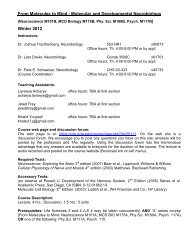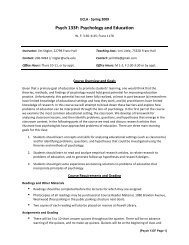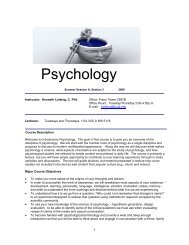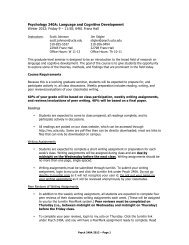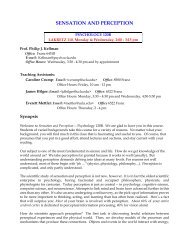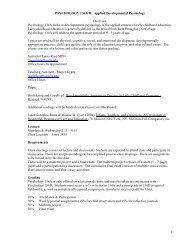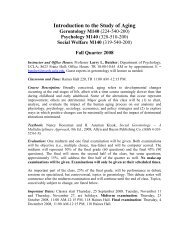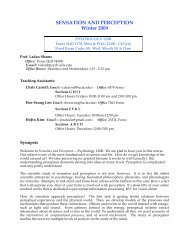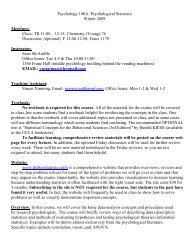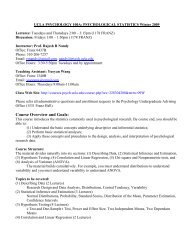Psychological Statistics - Courses in Psychology - UCLA
Psychological Statistics - Courses in Psychology - UCLA
Psychological Statistics - Courses in Psychology - UCLA
You also want an ePaper? Increase the reach of your titles
YUMPU automatically turns print PDFs into web optimized ePapers that Google loves.
<strong>Psychology</strong> 100A: <strong>Psychological</strong> <strong>Statistics</strong><br />
Fall 2009<br />
Lectures:<br />
Class: TR 12:30 – 1:45, Franz 1178<br />
Discussion: (optional) F 12:00-12:50, Humanities A51<br />
Instructor:<br />
Sean McAuliffe<br />
Office hours: Tue 11:00-12:00 & Thu 2:00-3:00<br />
1346 Franz Hall (middle psychology build<strong>in</strong>g beh<strong>in</strong>d the vend<strong>in</strong>g mach<strong>in</strong>es)<br />
EMAIL: vpstatman@hotmail.com<br />
Teach<strong>in</strong>g Assistant:<br />
Wenj<strong>in</strong>g Huang: wjhuang@ucla.edu, Office hours: Wed, Fri 1:30-2:30, FH 3621A<br />
Website:<br />
www.TheBest<strong>Statistics</strong>.Info is a comprehensive statistics website. There is a free version<br />
and a subscription version.<br />
The free version (www.thebeststatistics.<strong>in</strong>fo/free<strong>in</strong>dex.html) conta<strong>in</strong>s …<br />
* Comprehensive overviews of all material for this class<br />
* Review questions/answers on each topic<br />
The subscription version ($30 for a 3 month subscription) also conta<strong>in</strong>s …<br />
* Customizable step-by-step problem solvers for statistical analyses with graphical displays<br />
* Interactive demonstrations to illustrate important concepts<br />
Subscrib<strong>in</strong>g to the site is NOT required for the course, but students <strong>in</strong> the past have<br />
found it very useful (The median rat<strong>in</strong>g is 9 out of 10).<br />
The website will frequently be used <strong>in</strong> class to show how to solve problems as well as<br />
visually demonstrate important concepts.
Textbook:<br />
Because the free and subscription websites provide detailed overviews of the material,<br />
no textbook is required for this course. The recommended OPTIONAL text is “Statistical<br />
Concepts for the Behavioral Sciences (3rd Edition)” by Harold KIESS (available <strong>in</strong> the <strong>UCLA</strong><br />
bookstore). One problem is that the textbook will cover additional topics not presented <strong>in</strong> class, and<br />
<strong>in</strong> some cases will use different term<strong>in</strong>ology which some students f<strong>in</strong>d confus<strong>in</strong>g.<br />
Review materials:<br />
To facilitate learn<strong>in</strong>g, comprehensive review materials will be posted on the course web<br />
page for every lecture.<br />
Friday discussion sections:<br />
There will be no new material <strong>in</strong>troduced <strong>in</strong> the Friday discussion sections, so you are not<br />
required to attend, but many students f<strong>in</strong>d them helpful.<br />
Overview:<br />
In this course, we will cover the basic data-analysis concepts and procedures used by<br />
research psychologists. The course will briefly review ways of describ<strong>in</strong>g data (descriptive<br />
statistics) and methods of evaluat<strong>in</strong>g hypotheses and test<strong>in</strong>g psychological theories (<strong>in</strong>ferential<br />
statistics). Examples will be drawn almost exclusively from the psychological literature.<br />
Specific topics <strong>in</strong>clude correlation, t-tests, and ANOVA.<br />
Course Requirements and Grad<strong>in</strong>g:<br />
It is very important that you attend all classes <strong>in</strong> order to keep up with the material.<br />
Your grade will depend on your performance on the midterms and f<strong>in</strong>al exams. If you miss<br />
some lectures and get lost, you will be <strong>in</strong> serious trouble because concepts build on other<br />
concepts. <strong>Statistics</strong> is cumulative but the exams emphasize recent materials. All exam material<br />
will come from lectures.<br />
Grad<strong>in</strong>g basis:<br />
Exam When Total Po<strong>in</strong>ts Format<br />
Exam 1 Thursday Oct 15 30 15 Multiple Choice, 15 One Answer<br />
(<strong>in</strong> class)<br />
Exam 2 Thursday Nov 19 30 15 Multiple Choice, 15 One Answer<br />
(<strong>in</strong> class)<br />
F<strong>in</strong>al Friday Dec 11<br />
(11:30-2:30)<br />
60 30 Multiple Choice, 30 One Answer
As you will learn <strong>in</strong> the course, the distribution of scores can be described <strong>in</strong> a standardized<br />
way. A Z-score is a standardized score which <strong>in</strong>dicates how far a particular score is away from<br />
the mean (or average) score <strong>in</strong> terms of standard deviations (a measure of how wide a<br />
distribution is). Exam scores that are above the mean will have a positive Z-score, exam scores<br />
below the mean will have a negative Z-score. Your average Z-score on all the exams will<br />
determ<strong>in</strong>e your grade. The f<strong>in</strong>al exam will count twice as much as the other exams <strong>in</strong> this<br />
average. Below is the correspondence between the average Z-score and the grade you will<br />
receive. Next to the Z score is the approximate % of the class that will get that grade.<br />
Average Z-score Grade Approximate % of class receiv<strong>in</strong>g score<br />
>1.30 A 10<br />
>0.85 A- 10<br />
>0.55 B+ 10<br />
>0.25 B 10<br />
>0.00 B- 10<br />
>-0.25 C+ 10<br />
>-0.85 C 20<br />
>-1.30 C- 10<br />
>-1.70 D 5<br />
Miss<strong>in</strong>g-Exam:<br />
Under certa<strong>in</strong> EXTREME conditions (severe medical illness with complete medical<br />
documentation or death of an IMMEDIATE family member), ONE miss<strong>in</strong>g midterm exam can<br />
be substituted with the lowest Z-score of the rema<strong>in</strong><strong>in</strong>g exams. In this way, students who are<br />
consistent good performers need not be hurt by a miss<strong>in</strong>g exam.<br />
For example:<br />
Exam 1 Z=1.0<br />
Exam 2 Miss<strong>in</strong>g due to EXTREME case of Ebola<br />
F<strong>in</strong>al Exam Z = 1.2<br />
In this case, the miss<strong>in</strong>g exam would be scored as z=1.0 because 1.0 was the lowest z-score of<br />
the rema<strong>in</strong><strong>in</strong>g exams. In this case, the average z score would be (1.0+1.0+1.2+1.2)/4 = 4.4/4 =<br />
1.1 which would be an A-.<br />
Miss<strong>in</strong>g the FINAL exam will result <strong>in</strong> an F.<br />
Only ONE of the 2 midterm exams can be missed.<br />
No <strong>in</strong>completes, extra credit, etc. are given <strong>in</strong> 100A.<br />
Exam Difficulty:<br />
The exams are DIFFICULT. The scores are curved so this is really not a problem. In<br />
fact, hard exams are good because they allow the students who know more to dist<strong>in</strong>guish<br />
themselves from those who don’t know very much. An exam that is too easy does not allow for<br />
a wide enough spread <strong>in</strong> the distribution. Some of the exam questions will be similar to<br />
questions <strong>in</strong> the book or examples done <strong>in</strong> class. Some of the questions will require you to<br />
understand the concepts well enough to relate them to each other <strong>in</strong> a potentially novel way.<br />
Exam Format:<br />
Why are 1/2 of the exam questions not multiple choice?: Because multiple choice exams<br />
are unfair. They are unfair because they are greatly affected by guess<strong>in</strong>g. In addition, life is not<br />
a multiple choice exam. You won't get asked multiple choice questions <strong>in</strong> a job <strong>in</strong>terview.<br />
Although we would love to give you all one-answer questions, grad<strong>in</strong>g a large number of oneanswer<br />
exams would be too time-consum<strong>in</strong>g. Therefore, we have ½ multiple choice questions<br />
and ½ one-answer questions. This is not perfect, but not much <strong>in</strong> life is.<br />
Cheat<strong>in</strong>g:<br />
We hate cheaters and will do everyth<strong>in</strong>g possible to get you kicked out of school if we<br />
catch you. No kidd<strong>in</strong>g here – cheat<strong>in</strong>g is serious bus<strong>in</strong>ess and if we catch you, then you are<br />
history. Note – we have had a lot of experience at catch<strong>in</strong>g cheaters, so just don’t do it. Despite<br />
what you may have heard, <strong>UCLA</strong> will kick you out of school for a couple of semesters (or<br />
more) if you caught cheat<strong>in</strong>g.
Calculator Type:<br />
Fairness is very important <strong>in</strong> this class. The only way to be fair is to require that<br />
everyone has EXACTLY the same calculator. Go to the <strong>UCLA</strong> bookstore (on the B-level<br />
where the computers are), and buy the follow<strong>in</strong>g calculator for about $4:<br />
Aurora HC108X<br />
Many students will be annoyed that they have to buy a new calculator when they already<br />
have one, but there is no way of mak<strong>in</strong>g sure that different calculators have the same<br />
functionality (we can’t check 150 calculators dur<strong>in</strong>g the exam). Remember, you are not required<br />
to buy a textbook, which costs far more than a calculator.<br />
Any other calculators will not be allowed – NO EXCEPTIONS. In fact, you will lose<br />
5 po<strong>in</strong>ts on exam if you do not have the official calculator – your unofficial calculator will be<br />
taken dur<strong>in</strong>g the exam period and you will be given an official calculator for the exam. 5 po<strong>in</strong>ts<br />
is a lot of po<strong>in</strong>ts.<br />
Formula Sheets:<br />
No formula sheet will be given out for use dur<strong>in</strong>g the exams. Students often compla<strong>in</strong><br />
that memoriz<strong>in</strong>g a bunch of formulas is stupid because it is not conceptual. Unfortunately, this<br />
th<strong>in</strong>k<strong>in</strong>g is wrong. As you will learn <strong>in</strong> this course – the formula cannot be separated from the<br />
concept and <strong>in</strong> some cases the formula IS the concept.
Date Day Material<br />
Sep 24 Thu Introductory Materials<br />
Sep 29 Tue Central tendency and variability<br />
Oct 01 Thu Normal Distribution<br />
Sampl<strong>in</strong>g Distributions, Confidence<br />
Oct 06 Tue Intervals<br />
Oct 08 Thu Hypothesis test<strong>in</strong>g<br />
Oct 13 Tue Review for Exam 1<br />
Oct 15 Thu MIDTERM EXAM 1<br />
Oct 20 Tue two sample dependent T-tests<br />
Oct 22 Thu two sample <strong>in</strong>dependent T-tests<br />
Oct 27 Tue power, experimental design<br />
Oct 29 Thu power, experimental design<br />
Nov 03 Tue Power/one-way ANOVA (between)<br />
Nov 05 Thu one-way ANOVA (between)<br />
Nov 10 Tue one-way ANOVA (with<strong>in</strong>)<br />
Nov 12 Thu two-way ANOVA (between)<br />
Nov 17 Tue Review for Exam 2<br />
Nov 19 Thu MIDTERM EXAM 2<br />
Nov 24 Tue Correlation<br />
Nov 26 Thu No Class - Thanksgiv<strong>in</strong>g<br />
Dec 01 Tue Regression & Chi-square<br />
Dec 03 Thu F<strong>in</strong>al review<br />
Dec 11 Fri FINAL EXAM 11:30-2:30 <strong>in</strong> class



